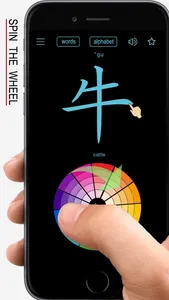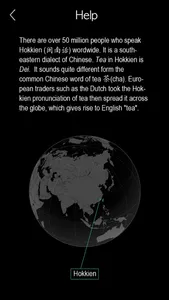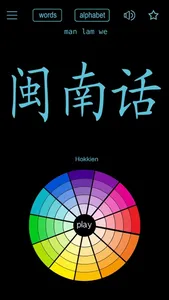LET'S LEARN THE HOKKIEN (MIN NAN) LANGUAGE !
THIS APP BREAKS THEM DOWN STROKE BY STROKE !
• SPIN THE WHEEL TO EXPLORE
It's so easy and natural.
• ADD TO FAVORITES
Save the word you like for the future use.
• REAL HUMAN VOICE
Including the alphabet, words.
• ENGLISH MEANINGS
All of the words have their meanings in English.
• HOKKIEN ARTS & CULTURE
Hokkien cuisine and culture illustrations.
• OFF-LINE INDEPENDENT
Once downloaded, you don't need internet to use the app. All audios and pictures are integrated within.
You can select the word in alphabetical order (English meanings) by clicking “words” in the menu bar. Basic everyday Hokkien words!
Click on the "alphabet" button in the menu bar, you can get the sound elements of the Hokkien language.
The apostrophe character indicates there is a nose pronunciation. For example, di’ has a nasal sound at the vowel i. And ’gua has a nasal sound at the consonant /g/ .
There are over 50 million people who speak Hokkien worldwide. It is a southeastern dialect of Chinese. It played an important role in the South China Sea region. For instance, Tea in Hokkien is Dei. It sounds quite different form the common Chinese word of tea 茶(cha). European traders such as the Dutch took the Hokkien pronunciation of tea then spread it across the globe, which gives rise to English "tea".
This app gives you a taste of Hokkien!
THIS APP BREAKS THEM DOWN STROKE BY STROKE !
• SPIN THE WHEEL TO EXPLORE
It's so easy and natural.
• ADD TO FAVORITES
Save the word you like for the future use.
• REAL HUMAN VOICE
Including the alphabet, words.
• ENGLISH MEANINGS
All of the words have their meanings in English.
• HOKKIEN ARTS & CULTURE
Hokkien cuisine and culture illustrations.
• OFF-LINE INDEPENDENT
Once downloaded, you don't need internet to use the app. All audios and pictures are integrated within.
You can select the word in alphabetical order (English meanings) by clicking “words” in the menu bar. Basic everyday Hokkien words!
Click on the "alphabet" button in the menu bar, you can get the sound elements of the Hokkien language.
The apostrophe character indicates there is a nose pronunciation. For example, di’ has a nasal sound at the vowel i. And ’gua has a nasal sound at the consonant /g/ .
There are over 50 million people who speak Hokkien worldwide. It is a southeastern dialect of Chinese. It played an important role in the South China Sea region. For instance, Tea in Hokkien is Dei. It sounds quite different form the common Chinese word of tea 茶(cha). European traders such as the Dutch took the Hokkien pronunciation of tea then spread it across the globe, which gives rise to English "tea".
This app gives you a taste of Hokkien!
Show More







